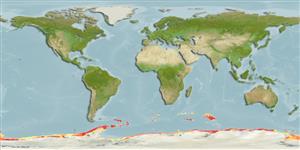Environment: milieu / climate zone / depth range / distribution range
Écologie
marin démersal; océanodrome (Ref. 51243); profondeur 1 - 1010 m (Ref. 114491). Polar; 45°S - 78°S, 180°W - 180°E
Circumpolar south of Antarctic Polar Front, but not found in Ross Sea; adults only in higher latitudes (South Orkneys, South Shetlands, Peter Island) and south of the Weddell-Scotia confluence, but adults and juveniles in the region of South Sandwich I, South Georgia and Bouvet. Reported from off the Cape, South Africa and from 43°17'S, 48°55'E (Ref. 4066).
Length at first maturity / Taille / Poids / Âge
Maturity: Lm 7.4 range ? - ? cm
Max length : 11.5 cm SL mâle / non sexé; (Ref. 114491); 10.3 cm SL (female); poids max. publié: 15.00 g (Ref. 124149); âge max. reporté: 4 années (Ref. 94119)
Épines dorsales (Total) : 0; Rayons mous dorsaux (Total) : 14 - 16; Épines anales: 0; Rayons mous anaux: 19 - 22.
Oceanic and mesopelagic, found in the upper 100 m south of the Antarctic Polar Front but deeper northwards (Ref. 4066). Adults take more euphausiids and also prey upon polychaetes. The diet of juveniles of less than 6 cm SL consists mainly of copepods, with some euphausiids and hyperiids. Possibly the most common myctophid occurring south of the Antarctic Polar Front.
Life cycle and mating behavior
Maturities | Reproduction | Spawnings | Egg(s) | Fecundities | Larves
Hulley, P.A., 1990. Myctophidae. p. 146-178. In O. Gon and P.C. Heemstra (eds.) Fishes of the Southern Ocean. J.L.B. Smith Institute of Ichthyology, Grahamstown, South Africa. (Ref. 5182)
Statut dans la liste rouge de l'IUCN (Ref. 130435)
Menace pour l'homme
Harmless
Utilisations par l'homme
Outils
Articles particuliers
Télécharger en XML
Sources Internet
Estimates based on models
Preferred temperature (Ref.
123201): -0.2 - 1.2, mean 0.4 °C (based on 610 cells).
Phylogenetic diversity index (Ref.
82804): PD
50 = 0.5312 [Uniqueness, from 0.5 = low to 2.0 = high].
Bayesian length-weight: a=0.00832 (0.00469 - 0.01475), b=3.09 (2.94 - 3.24), in cm total length, based on LWR estimates for this species & (Sub)family-body (Ref.
93245).
Niveau trophique (Ref.
69278): 3.2 ±0.4 se; based on diet studies.
Generation time: 6.5 ( na - na) years. Estimated as median ln(3)/K based on 2
growth studies.
Résilience (Ref.
120179): Milieu, temps minimum de doublement de population : 1,4 à 4,4 années (K=0.17-0.25; tmax=11).
Fishing Vulnerability (Ref.
59153): Moderate vulnerability (41 of 100).
Nutrients (Ref.
124155): Calcium = 63.5 [23.8, 202.8] mg/100g; Iron = 0.649 [0.225, 1.681] mg/100g; Protein = 15.4 [13.5, 17.5] %; Omega3 = 0.92 [0.39, 2.31] g/100g; Selenium = 13.9 [4.6, 38.8] μg/100g; VitaminA = 49.6 [8.9, 301.0] μg/100g; Zinc = 0.657 [0.347, 1.130] mg/100g (wet weight); based on
nutrient studies. 